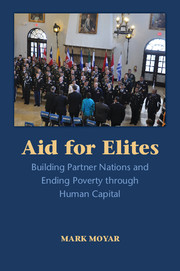Book contents
- Frontmatter
- Contents
- Preface
- Acknowledgments
- 1 Pathways to Development
- 2 How Governments Work
- 3 Civilization
- 4 Human Capital Development
- 5 Human Capital and National Security
- 6 Training
- 7 Militarization
- 8 Education in the Third World
- 9 Education in the United States
- 10 Support
- 11 Measurement
- 12 Conclusion: A New Foreign Assistance Strategy
- Notes
- Index
- Frontmatter
- Contents
- Preface
- Acknowledgments
- 1 Pathways to Development
- 2 How Governments Work
- 3 Civilization
- 4 Human Capital Development
- 5 Human Capital and National Security
- 6 Training
- 7 Militarization
- 8 Education in the Third World
- 9 Education in the United States
- 10 Support
- 11 Measurement
- 12 Conclusion: A New Foreign Assistance Strategy
- Notes
- Index
Summary
Funding for training and education represents the best use of foreign aid dollars, since they are the most important activities in human capital development. Aid can, however, be used in other ways that bolster the human capital of recipient nations, as this chapter will show. Some are targeted specifically at human capital, while others affect it indirectly. Their effectiveness varies greatly and is heavily dependent on local conditions.
FUNDS TRANSFERS
Donor nations can transfer funds to third world governments through a wide range of financial vehicles, which are distinguished most significantly by their degree of conditionality. Donors impose the fewest conditions on recipients with what the development community calls “budget support” – the depositing of funds directly into the bank accounts of governments for use as those governments see fit. The recent emphasis of development agencies on “local ownership” has increased the amount of aid provided in this manner. But budget support continues to run up against the problem of bad governance. Governmental leaders, as the keepers of the national treasuries, can all too easily divert state monies to palaces, offshore bank accounts, or patronage networks.
Even where theft of public funds is not rampant, the chances of unshackled foreign assistance funds reaching human capital development programs may be low. Human capital is not a high priority for many third world governments, which after all is a leading reason why they are third world governments. Spending on human capital development takes a long time to produce results and is not easy for politicians to advertise in an election season, unlike, say, building health clinics or handing out welfare checks.
In most countries, therefore, foreign donors who wish to ensure that their donations support human capital development must condition the transfer of funds on the allocation of those funds to specific programs. They must be prepared, in addition, to resort to the “tough love” approach of withdrawing funding commitments if the money is not used for the promised purpose. Past corruption scandals have, in fact, convinced many donors to withdraw funds in response to misuse.
Donors face the difficult task of imposing enough restrictions on the use of funds to prevent misuse while leaving enough latitude for the recipient government to take initiative and make adjustments based on its understanding of local conditions, which is almost always better than that of foreign donors.
- Type
- Chapter
- Information
- Aid for ElitesBuilding Partner Nations and Ending Poverty through Human Capital, pp. 167 - 184Publisher: Cambridge University PressPrint publication year: 2016

